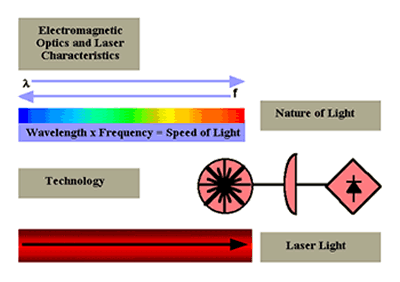APOL Optics Study
Optics:
Light refers to radiation in the ultraviolet, visible, and infrared portions of the electromagnetic spectrum. It has smaller wavelengths, or larger frequencies, than radio waves and longer wavelengths, or larger energies, than X-rays. The wavelength l is associated with color in the visible portion of the spectrum and is conventionally the preferred designation rather than frequency f or energy. Note that wavelength is typically defined as the wavelength in vacuum. The effective wavelength inside a material is then decreased by a factor 1 / sqrt(µr er). The frequency is related by the relation
¿ f = c = the speed of light and
¿ f / v(µr er) = c / sqrt(µr er ) = vp = the phase velocity.
 |
A variety of optical technologies exist for commercial, industrial, and scientific applications. One of the most important and significant technologies is the laser. Laser light has special properties which have led to the many developments in metrology, communication, imaging, etc.
Tutorials:
The principles and technology for optical applications are summarized in the following tutorial modules. Each module must be viewed before quiz 2 is attempted.
· Nature of Light – Optical spectrum, wave-photon duality, and optical phenomenon
· Technology – Sources, detectors, and beam control
· Laser Light – Spectral characteristics, beam properties, and applications
